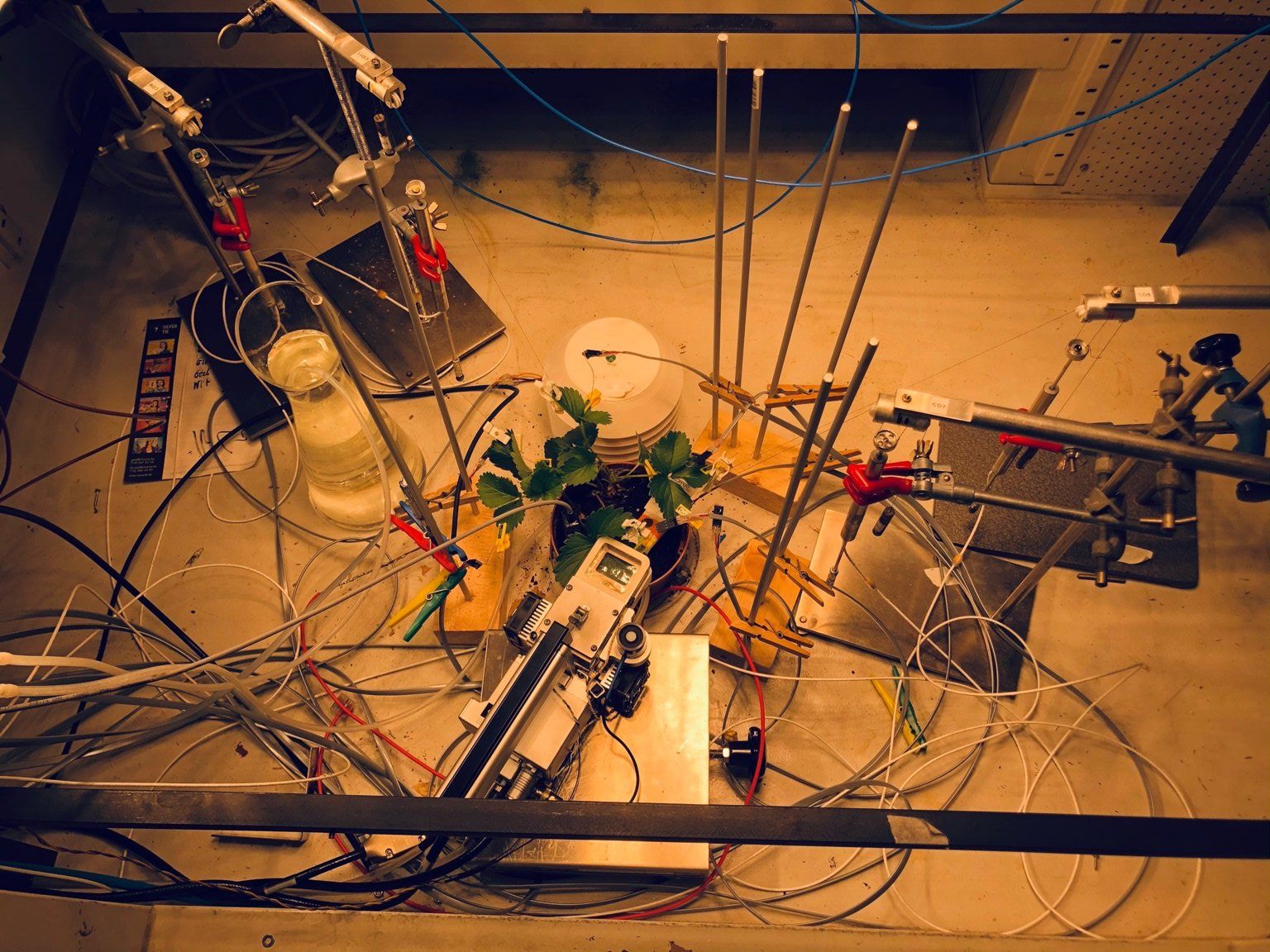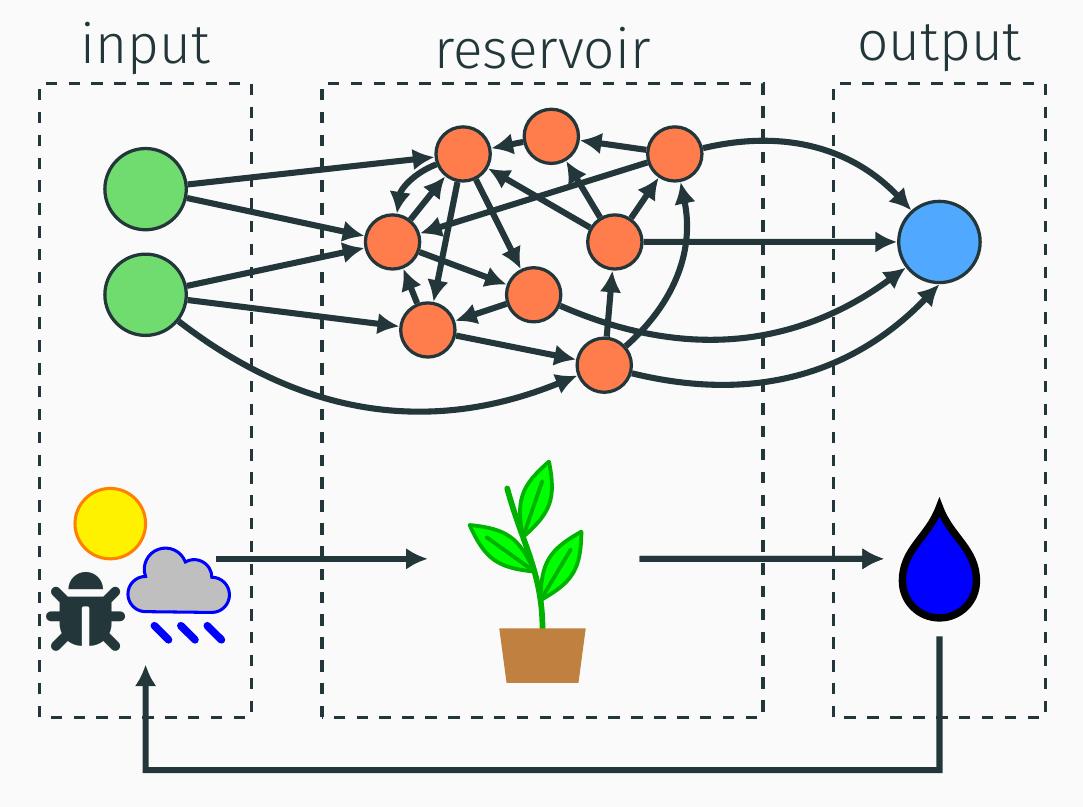Plants are complex and dynamic organisms that continuously sense changes in their environment and adapt their responses accordingly. However, these changes do not occur uniformly. We are investigating to what extent these differences occur, how they relate to each other, and how they can be used to improve plant productivity.
Plants are highly complex dynamical systems that react to a wide range of external and internal stimuli. Consequently, they exhibit emergent intelligent behaviour due to their sophisticated cells and cellular networks. These cells form the basis of plants’ extensive set of signal receptors and downstream physiological networks. In our research we consider plants as computing units, able to sense and interpret these signals and provide adequate responses that maximise fitness to the prevailing environmental conditions. More specifically, we are investigating whether the framework of physical reservoir computing is applicable to plants. Physical reservoir computing is the extension of reservoir computing to physical media. Instead of a simulated reservoir, a physical medium is used. A wide range of media is already explored within and outside the AIRO group. We now want to extend this to living organisms.
The analogy between a plant-based physical reservoir and general reservoir computing is depicted in the figure above. A wide range of biotic and abiotic factors form the input to the reservoir. Biotic factors include plant-plant interactions, pests, diseases, and temperature. Abiotic factors are precipitation, nutrient availability, for example. The instantaneous plant response is a combination of the current and past environment and is partially observable using sensors such as are RGB cameras, leaf length sensors and bio-impedance sensors. The target variables are formed by linearly combining the readout values from the sensors. Possible target functions include water flow, stomatal conductance and stresses.
Our goal is to show that by exploiting the computational capabilities of plants one can better understand complex plant behaviour and ultimately improve (the conditions for) crop growth. Additionally, it also offers an entirely new way of looking at plant responses, at a much more integrated scale.
Publications
Development of a quantitative comparison tool for plant models
In FSPM2020: Towards Computable Plants; 9th International Conference on Functional-structural Plant Models
2020
Gloxinia—an open-source sensing platform to monitor the dynamic responses of plants
Pieters, Olivier,
De Swaef, Tom,
Lootens, Peter,
Stock, Michiel,
Roldán-Ruiz, Isabel,
and
wyffels, Francis
SENSORS
2020
The study of the dynamic responses of plants to short-term environmental changes is becoming increasingly important in basic plant science, phenotyping, breeding, crop management, and modelling. These short-term variations are crucial in plant adaptation to new environments and, consequently, in plant fitness and productivity. Scalable, versatile, accurate, and low-cost data-logging solutions are necessary to advance these fields and complement existing sensing platforms such as high-throughput phenotyping. However, current data logging and sensing platforms do not meet the requirements to monitor these responses. Therefore, a new modular data logging platform was designed, named Gloxinia. Different sensor boards are interconnected depending upon the needs, with the potential to scale to hundreds of sensors in a distributed sensor system. To demonstrate the architecture, two sensor boards were designed—one for single-ended measurements and one for lock-in amplifier based measurements, named Sylvatica and Planalta, respectively. To evaluate the performance of the system in small setups, a small-scale trial was conducted in a growth chamber. Expected plant dynamics were successfully captured, indicating proper operation of the system. Though a large scale trial was not performed, we expect the system to scale very well to larger setups. Additionally, the platform is open-source, enabling other users to easily build upon our work and perform application-specific optimisations.
Leveraging plant physiological dynamics using physical reservoir computing
SCIENTIFIC REPORTS
2022
Plants are complex organisms subject to variable environmental conditions, which influence their physiology and phenotype dynamically. We propose to interpret plants as reservoirs in physical reservoir computing. The physical reservoir computing paradigm originates from computer science; instead of relying on Boolean circuits to perform computations, any substrate that exhibits complex non-linear and temporal dynamics can serve as a computing element. Here, we present the first application of physical reservoir computing with plants. In addition to investigating classical benchmark tasks, we show that Fragaria x ananassa (strawberry) plants can solve environmental and eco-physiological tasks using only eight leaf thickness sensors. Although the results indicate that plants are not suitable for general-purpose computation but are well-suited for eco-physiological tasks such as photosynthetic rate and transpiration rate. Having the means to investigate the information processing by plants improves quantification and understanding of integrative plant responses to dynamic changes in their environment. This first demonstration of physical reservoir computing with plants is key for transitioning towards a holistic view of phenotyping and early stress detection in precision agriculture applications since physical reservoir computing enables us to analyse plant responses in a general way: environmental changes are processed by plants to optimise their phenotype.
Limitations of snapshot hyperspectral cameras to monitor plant response dynamics in stress-free conditions
Pieters, Olivier,
De Swaef, Tom,
Lootens, Peter,
Stock, Michiel,
Roldán-Ruiz, Isabel,
and
wyffels, Francis
COMPUTERS AND ELECTRONICS IN AGRICULTURE
2020
Plants’ dynamic eco-physiological responses are vital to their productivity in continuously fluctuating conditions, such as those in agricultural fields. However, it is currently still very difficult to capture these responses at the field scale for phenotyping purposes. Advanced hyperspectral imaging tools are increasingly used in phenotyping, and have been applied to detect changes in plants in response to a specific treatment, phenological state or monitor its growth and development. Phenotyping has to evolve towards capturing dynamic behaviour under more subtle fluctuations in environmental conditions, without the presence of clear treatments or stresses. Therefore, we investigated the potential of hyperspectral imaging to capture dynamic behaviour of plants in stress-free conditions at a temporal resolution of seconds. Two growth chamber experiments were set up, in which strawberry plants and four different background materials, serving as controls, were monitored by a snapshot hyperspectral camera in variable conditions of light, temperature and relative humidity. The sampling period was set to three seconds, triggering image acquisition and gas exchange measurements. Different background materials were used to assess the influence of the environment and the camera in both experiments. To separate the plant and background data, static masks were determined. Two datasets were created, which encompass both experiments. One dataset was constructed after averaging over the entire mask to acquire one value per spectral band. These values were then used to calculate a set of vegetation indices. The other dataset used spatial subsampling to retain spatial information. From both datasets, linear models were constructed using ridge regression, which estimated the measured eco-physiological and environmental data. Leaf temperature and vapour pressure deficit based on leaf temperature are the two main eco-physiological characteristics that could be predicted successfully. Stomatal conductance, photosynthesis and transpiration rate show less promising results. We suspect that limited variation, and low spectral resolution and range are the main causes of the inability of the models to extract meaningful predictions. Furthermore, the models that were only trained on background data also showed good predictive performance. This is probably because the main drivers for good performing eco-physiological variables are temperature and incident light intensity. Environmental characteristics that have good performance are photosynthetically active radiation and air temperature. Current hyperspectral sensing technologies are not yet able to uncover most plant dynamic eco-physiological responses when plants are cultivated in stress-free conditions.
On the pivotal role of water potential to model plant physiological processes
De Swaef, Tom,
Pieters, Olivier,
Appeltans, Simon,
Borra-Serrano, Irene,
Coudron, Willem,
Couvreur, Valentin,
Garré, Sarah,
Lootens, Peter,
Nicolaï, Bart,
Pols, Leroi,
Saint Cast, Clément,
Šalagovič, Jakub,
Van Haeverbeke, Maxime,
Stock, Michiel,
and
wyffels, Francis
IN SILICO PLANTS
2022
Water potential explains water transport in the Soil-Plant-Atmosphere Continuum (SPAC), and is gaining interest as connecting variable between ‘pedo-, bio- and atmosphere’. It is primarily used to simulate hydraulics in the SPAC, and is thus essential for studying drought effects. Recent implementations of hydraulics in large-scale Terrestrial Biosphere Models (TBMs) improved their performance under water-limited conditions, while hydraulic features of recent detailed Functional-Structural Plant Models (FSPMs) open new possibilities for dissecting complex traits for drought tolerance. These developments in models across scales deserve a critical appraisal to evaluate its potential for wider use in FSPMs, but also in crop systems models (CSMs), where hydraulics are currently still absent. After refreshing the physical basis, we first address models where water potential is primarily used for describing water transport along the transpiration pathway from the soil to the leaves, through the roots, the xylem and the leaf mesophyll. Then, we highlight models for three ecophysiological processes, which have well-recognised links to water potential: phloem transport, stomatal conductance and organ growth. We identify water potential as the bridge between soil, root and shoot models, as the physiological variable integrating below- and above-ground abiotic drivers, but also as the link between water status and growth. Models making these connections enable identifying crucial traits for ecosystem resilience to drought and for breeding towards improved drought tolerance in crops. Including hydraulics often increases model complexity, and thus requires experimental data on soil and plant hydraulics. Nevertheless, modelling hydraulics is insightful at different scales (FSPMs, CSMs and TBMs).

